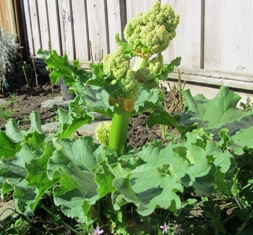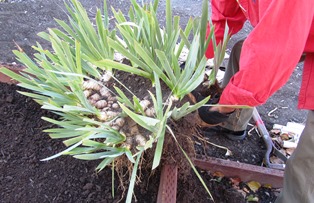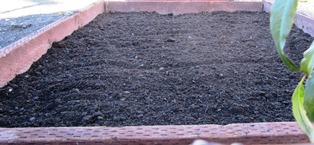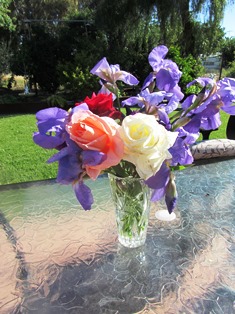The Joy of Growing Iris
Nothing beats the joy of an early morning walk in a garden and seeing iris plants in full bloom. These beauties are easy to grow, vigorous reproducers, and deer resistant.

Iris need six to eight hours of sun each day. If you live in a hot climate, your iris will need some shade protection. They perform best in well-drained soil.
The best time of the year to plant iris seems to be late summer or early fall when the temperature does not fall below 40 degrees Fahrenheit.
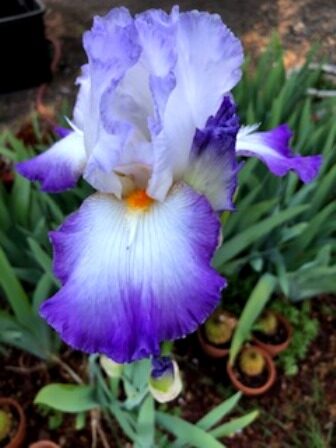
The rhizomes of iris tend to spread, so you’ll want to divide the clumps every three to four years. The best time to divide them is about six weeks after flowering.
To divide, dig up the clump, pull the rhizomes (roots) from the sides of the mother plant and then plant the new rhizomes, burying them so that the roots are pointing down and the top foliage (even if you have cut it back to a few inches) is exposed. Cover with soil, tamp down, and water well.
Space the iris rhizomes at least one to two feet apart. Planting too close together reduces the number of blooms. There are many varieties of iris to choose for your garden; two of the most common types are Bearded iris and Siberian iris. Plant some of these beauties and experience the joy of seeing them bloom in your garden.

If you enjoy reading about gardening and country living topics, check out my series of cozy mysteries based on my life on the “real” Henny Penny Farmette. The novels are chocked full of tips on gardening, keeping chickens and bees, and growing heirloom vegetables and fruits.
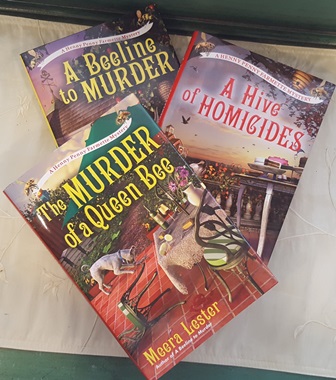
Barnesandnoble.com, and other online bookstores
My novels and self-help, spirituality, and wellness books are offered online and everywhere books are sold. Check out my author’s page on Amazon and also on Simon and Schuster.com.–Meera Lester
Plant Dahlias and Canna Lilies Now for Dazzling Summer Color
Love the tropical foliage and brilliant color of dahlia and Canna lily blooms? Plant them now through April if you live in Zones 8 through 11. Long prized as cut flowers for bouquets, dahlias and Canna lilies do not fail to dazzle also when grouped in flowerbeds alone or with other summer blooming plants.
Indigenous to Central Mexico, dahlias are herbaceous, leafy plants that offer blooms in a wide assortment of colors (except blue and black). Bloom size ranges from a couple of inches across to roughly a foot wide (the largest size is known as “dinner-plate”). Tall varieties need staking and all types can benefit from dead-heading when blooms are spent.
Dahlia roots are actually tubers and do best when planted in moist, well-drained, loamy soil. If growing them in areas where there is frost, dig and store the tubers in a cool, dry (and frost-free) place in the fall for re-planting the next year. In extreme climates like the high desert, dahlias benefit from several inches of mulch covering the bed.
The main pests of dahlias are slugs, snails, earwigs, leaf hoppers, and aphids. Powdery mildew and gray mold can also infect the plant.
Canna lilies, like dahlias, are herbaceous summer-blooming plants that come in a wide variety of colors. Indigenous to sub-tropical areas of North and South America, Cannas can be grown as perennials in zones 7 through 11, according to the U.S. Department of Agriculture. In other zones with more extreme climates, mulch the plants two to four inches deep or lift the rhizomes (roots) and store them in dry peat moss in a cool, dry place until ready to replant.
Plant rhizomes of tall Canna lilies at the back of the flowerbed (or at the front of the bed if the plants are dwarf) in three to six inches of rich, well-drained soil. Position so that the eyes are facing up. Pests include slugs, snails, Canna leaf-rollers, and Japanese beetles. Aphids can spread canna viruses that can cause leaf streaking and bloom disfigurement. The plants are heavy feeders so will need a good organic fertilizer when they begin to look ratty and two to four inches of water each week.
Use tall dahlias and Canna lilies at the back of your flowerbed and add mid-size blooming plants in the middle and dwarf or low growing bedding plants with lots of color at the front to create a spectacular garden area this summer. If you live in a relatively frost-free zone, your dahlias and Canna lilies will spring back to life and carry on with colorful displays amid tropical foliage for years to come.
__________________________________________________________________________________
If you enjoy reading about gardening and the natural world, check out my series of cozy mysteries that include information on growing heirloom plants and keeping chickens and bees. Also see my self-help empowerment and well-being books. All are available online and in bookstores everywhere.

The Henny Penny Farmette series of cozy mysteries–lots of delicious recipes and information for country living
CLICK ON THE LINK to see more.
Rhubarb–That “Pie Plant”
In my grandmother’s time, rhubarb’s moniker was the “pie plant” for the simple reason that the tart flavor of its canes nicely tempers the cloying sweetness of other fruits.
Rhubarb, long treated as a fruit, is actually a vegetable. In bygone days when tariffs on imported vegetables were higher than on fruit, a New York court decided in favor of labeling rhubarb as fruit for the purposes of taxation and tariff regulations.
One of the first edibles in the spring garden, rhubarb pushes up leaf stalks or canes (what botanists call petioles) with large leaves. The leaves are are high in oxalic acid and thus poisonous to consume (when harvesting, cut off the tops and discard; snap off the canes for cooking).
Rhubarb stalks or canes, when cooked with sugar or apples (to sweeten), are delicious in pies, jams, sauces and fruit tarts.
Rhubarb is easy to grow (in warm climates, it grows year-round). In cold climates, its leaves and canes will die but the rhizome root will generate new shoots come spring. But if it blooms, cut off the bloom to ensure the root continues to produce canes.
The plant can also be grown in large containers or in greenhouses. It is not fussy about soil, produces new canes year after year, and loves sunlight.
Consumers love those red canes, but rhubarb canes, depending on the variety, aren’t always red–some are light green or pink speckled. The flavor of the light green canes, the type growing on our farmette, has the most robust flavor.
While creating a space for some new plants, we decided to dig out one of our rhubarb plants. That little rhizome I put in the ground four years ago had produced roots 20 inches into the earth. Above ground the plant had grown roughly three feet high and as wide. We will divide it and replant, since it’s a good idea anyway to divide every 3 to 4 years.
We grow Victoria, an old variety with a tendency to flower (or bolt). We prefer to remove those flower spikes in order to keep the plant producing new canes and leaves. Blooms tend to waste the plants resources, see http://www.gardeningknowhow.com/edible/vegetables/rhubarb/rhubarb-bolting.htm. Also see, http://www.hort.purdue.edu/ext/rhubarbflowers.html
In an upcoming posting, I’ll include some recipes for using rhubarb from your garden. In the meantime, consider the different varieties available and perhaps try planting a new and different cultivar. See, http://www.rhubarbinfo.com/varieties.
The Benefits of Bamboo
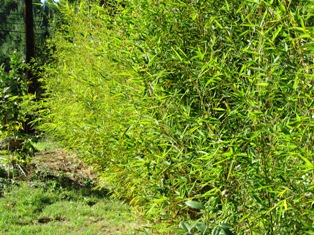
Bamboo plants make great screens, clipped hedges, or a dramatic foil for plants layered in front of it.
Bamboo plants are favored by environmentalists because they are drought tolerant, can be used for erosion control, are not fussy about soil, make fast-growing hedges or screens, and quickly naturalize.
We grow mainly the clumping type of bamboo because it makes very little horizontal growth and stays tightly clumped. It just gets dense.
The runner type, however, spreads through underground stems that grow out from the rhizome. These are the types of bamboos that reach considerable heights and form groves.
Dividing the plants helps maintain control of these woody-stemmed giant grasses.
Spring is the best time to divide bamboo plants. Although spring is still a few days away, we are dividing the bamboo that thrives along our farmette fences and planting it as a screen on the side of the house where we can see traffic from the road.
Although bamboo has gotten a bad rap for spreading into areas where it isn’t wanted, it can be confined in containers or by inserting metal or concrete barriers into the soil to prevent unwanted invasion by the runner type.
The plant’s evergreen leaves on tall, slender stems look graceful swaying in the breeze and, coupled with its other benefits, make bamboo a good choice for some landscapes.
Divide Irises to Regenerate the Plant and Get Spectacular Blooms
Dividing the rhizomes of bearded iris plants is an easy and necessary process as the plant ages. The division process is best done during late summer or early fall, but we are doing this job now on our farmette.
The rhizome is a thick tuberous type of structure that sends up stems and leaves and also produces roots. Many gardeners divide their iris clumps every three to four years. Our beds of iris have become overcrowded with many new baby plants. It’s time to divide.
Before we move our iris from the side garden to planter boxes made of pressure-treated redwood, we prepare the soil in those boxes. We amend it with low-nitrogen fertilizer and compost.
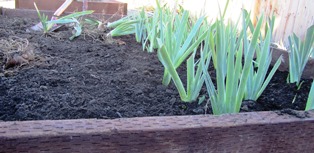
These iris are planted too close–they will be replanted to 16 inches apart for air to circulate and for growing room
We cut back the foliage and pull off any of the sword-shaped leaves that have dried. Then we gently pull apart the new growth from the old clump. Pruning and cutting back the leaves helps ensure that pests do not overwinter.
The rhizome produces more rhizomes over time. Eventually the original rhizome will wither and die. Regularly dividing the clumps ensures new baby plants and blooms for years to come.
 Facebook
Facebook Goodreads
Goodreads LinkedIn
LinkedIn Meera Lester
Meera Lester Twitter
Twitter









